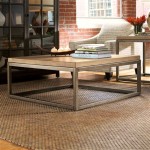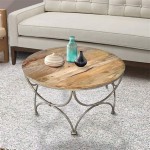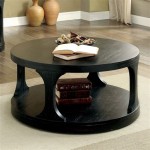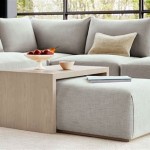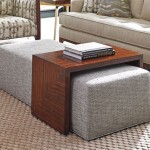What Is The Normal Height For A Coffee Table?
Selecting furniture for a living space involves considering various factors, including aesthetics, functionality, and spatial harmony. Among the essential pieces, the coffee table holds a significant position. It serves as a focal point, provides a surface for drinks and décor, and contributes to the overall flow of the room. A crucial aspect of choosing the right coffee table is its height. Determining the normal or appropriate height for a coffee table is not arbitrary; it is guided by ergonomic principles and considerations of visual balance within the room.
The concept of a "normal" height for a coffee table is not a fixed standard, but rather a guideline influenced by several variables. These variables include the height of the sofa or seating arrangement it will accompany, the intended use of the table, and the overall style of the room. Understanding these influencing factors is essential in selecting a coffee table that is both functional and visually appealing.
Traditionally, the generally accepted height range for a coffee table falls between 16 and 18 inches. This range is often considered the "normal" or standard height. However, this standard is not universally applicable and should be viewed as a starting point for customization. In spaces with lower seating, a lower coffee table may be more appropriate. Conversely, higher seating arrangements may necessitate a taller coffee table.
The primary reason for considering the height of the sofa or seating is to ensure comfortable access and functionality. A coffee table that is too low can be difficult to reach, requiring excessive bending, while one that is too high can obstruct the view and create an awkward aesthetic. The ideal scenario is a coffee table that sits at roughly the same height as the seat cushions of the sofa, or slightly lower.
While the 16-18 inch range provides a general baseline, it is important to examine the specific measurements of the seating arrangement. If the sofa has a seat height of 17 inches, a coffee table within the 15-17 inch range would be a suitable choice. This allows for easy access to items placed on the table without compromising comfort or visual appeal. When selecting a coffee table, bring a tape measure to accurately assess the height of the seating and ensure a sensible match.
The intended use of the coffee table also plays a crucial role in determining the appropriate height. If the table is primarily intended for decorative purposes, such as displaying books, plants, or art objects, a slightly lower height may be acceptable. A lower profile can enhance the visual impact of the decorative items, allowing them to become more prominent features in the room.
However, if the coffee table is intended for more functional purposes, such as serving drinks, snacks, or as a surface for working, a height closer to the sofa's seat height is preferable. This ensures that items on the table are easily accessible and minimizes the need for excessive reaching or bending. For individuals who frequently use the coffee table for dining or working, a slightly taller table, even one that exceeds the standard 18-inch range, may be the most practical choice.
The style and design of the room should also be taken into account when determining the normal height of a coffee table. In contemporary or minimalist spaces, a lower coffee table can contribute to a sleek and streamlined aesthetic. Lower profiles often reinforce the clean lines and uncluttered feel that are characteristic of these styles. Alternatively, in more traditional or eclectic spaces, a taller coffee table with more ornate detailing may be a better fit. The table's height should complement the other elements in the room, creating a sense of visual harmony and balance.
Beyond the standard height ranges, specialty coffee tables offer alternative options that cater to specific needs and preferences. Lift-top coffee tables, for example, feature a mechanism that allows the tabletop to be raised to a higher level, transforming the table into a temporary workspace or dining surface. These tables are particularly useful in small apartments or multi-functional spaces where versatility is essential.
Ottomans, which can double as coffee tables, often have a lower profile than traditional coffee tables. They can be a comfortable and stylish alternative, especially in casual or informal living spaces. However, ottomans used as coffee tables typically require a tray or other surface to provide a stable platform for drinks or other items.
Nesting coffee tables offer another adaptable solution. These tables consist of two or more tables of varying sizes that can be nested together when not in use or separated to provide additional surface space when needed. The height of the individual tables can vary, but they are generally designed to complement each other aesthetically and functionally.
The material and design of the coffee table can also influence the perceived height. A coffee table with thick legs or a substantial base may appear taller than a table with a more delicate frame, even if the actual height is the same. Similarly, a glass-topped coffee table may appear less imposing than a solid wood table, regardless of height.
When choosing a coffee table, it is important to consider the overall proportions of the room. In a small room, a large or bulky coffee table can overwhelm the space and make it feel cramped. Conversely, in a large room, a smaller coffee table may appear insignificant and fail to create a focal point. Selecting a coffee table that is appropriately scaled to the room is essential for achieving a balanced and harmonious design.
The placement of the coffee table relative to the sofa and other seating is also a critical factor. A coffee table that is too close to the seating can impede movement and make it difficult to access other areas of the room. A coffee table that is too far away can be inconvenient and require excessive reaching. The ideal distance between the coffee table and the sofa is typically around 14 to 18 inches. This allows for comfortable legroom while still providing easy access to the table.
The Importance of Sofa and Seating Height
The height of the sofa or seating arrangement is the most significant factor in determining the ideal coffee table height. Traditionally, the standard height for a sofa seat ranges from 17 to 18 inches. This is the benchmark to which coffee table height is generally compared. If the sofa sits lower, perhaps around 15 or 16 inches, then a coffee table in the 14 to 16-inch range would be more appropriate. This ensures ease of access without requiring individuals to strain or stretch uncomfortably. Conversely, for sofas with higher seat heights, a coffee table approaching or even slightly exceeding 18 inches may be preferable.
It is essential to measure the height of the sofa seat from the floor to the top of the cushion when it is compressed under normal seating weight. This ensures an accurate measurement that reflects the true height of the seating surface. Relying on manufacturer specifications alone may not be sufficient, as cushion compression can significantly alter the actual seat height.
Besides the sofa, the presence of other seating arrangements, such as armchairs or loveseats, can also influence the choice of coffee table height. If the seating arrangement includes a mix of different heights, it may be necessary to select a coffee table height that is a compromise between the various seating options. Alternatively, using multiple coffee tables of different heights can provide a more customized and flexible solution.
The Function and Usage of the Coffee Table
The intended function of the coffee table will shape its height requirements. If the table is primarily for aesthetic purposes, a lower profile can be more visually appealing. This is because a lower table showcases decorative items more effectively and creates a sense of spaciousness in the room. In contrast, a table meant for practical usage, such as holding beverages, snacks, or remote controls, requires a height that allows for easy access without excessive bending. This typically necessitates a coffee table closer in height to the sofa seat.
Consideration should also be given to the daily habits of the occupants. If individuals frequently eat or work on the coffee table, a taller option, perhaps even a lift-top table, could be the most practical choice. A lift-top table can be raised to a comfortable height for dining or working, then lowered to its normal position when not in use. For families with young children, a lower coffee table with rounded edges may be a safer option.
The type of activities that will take place around the coffee table should also be taken into account. If the table is frequently used for board games or puzzles, a larger surface area and a height that allows for comfortable reach and visibility are essential. On the other hand, if the table is primarily used for displaying coffee table books or decorative items, a smaller surface area and a lower height may be more suitable.
Room Style and Design Considerations
The overall style and design of the room must harmonize with the height of the coffee table. In contemporary and minimalist designs, lower coffee tables often contribute to the clean and streamlined aesthetic. The lower profile reinforces the sense of openness and uncluttered space that is characteristic of these styles. Materials such as glass, metal, and light-colored wood are frequently used in contemporary coffee tables.
In traditional or transitional spaces, a taller coffee table with more substantial detailing may be a better fit. These tables often feature ornate legs, carved details, and rich wood finishes. The height of the table should complement the other elements in the room, such as the sofa, armchairs, and area rugs, creating a sense of visual harmony and balance.
Rustic or farmhouse-style rooms may benefit from a coffee table with a more rugged and natural aesthetic. These tables often feature reclaimed wood, exposed hardware, and a distressed finish. The height of the table should be proportionate to the other furniture in the room and contribute to the overall sense of warmth and informality.
In eclectic or bohemian spaces, a wider range of coffee table heights and styles may be appropriate. The key is to create a cohesive and visually interesting arrangement that reflects the individual tastes and preferences of the occupants. Mixing different heights, materials, and finishes can add to the eclectic charm of the room.
Ultimately, determining the normal height for a coffee table requires careful consideration of several factors, including the height of the seating arrangement, the intended use of the table, and the overall style of the room. By taking these factors into account, it is possible to select a coffee table that is both functional and aesthetically pleasing, contributing to a comfortable and visually harmonious living space. The measurement and assessment of the existing space are important for a correct selection.

The Ultimate Coffee Table Size Guide Apt2b

Barlow Tyrie Linear 120cm Coffee Table Premium Stockist

Coffee Table Size Guide Everything You Need To Know About Dimensions

Star Furniture

How To Choose The Right Coffee Table Dimensions Doğtaş

Steve Silver Yves 48 In Charcoal 19 5 H Rectangle Wood Coffee Table With Lift Top Ys100c The Home Depot

Coffee Table Dimension Guide Ashley

Coffee Table Guide Height Styles Decoration Vaunt Design

How To Choose The Right Coffee Table Dimensions Doğtaş

Coffee Tables Buy Table Upto 70 Off Pepperfry
Related Posts

